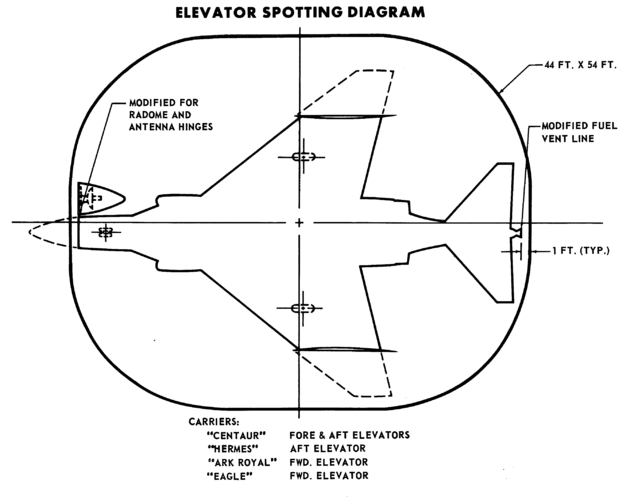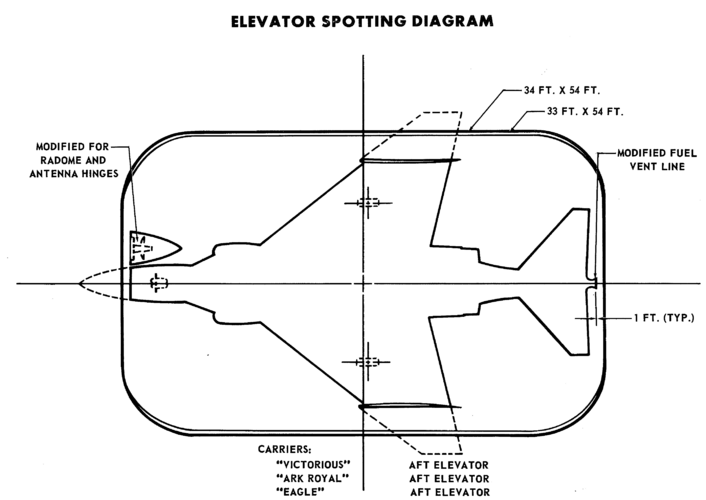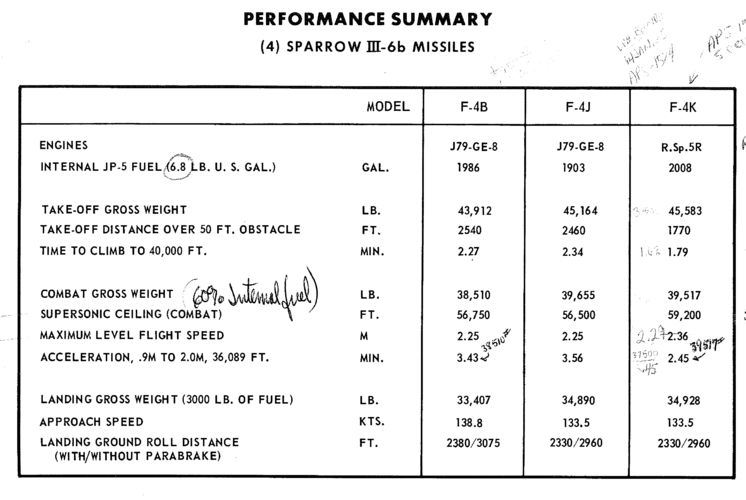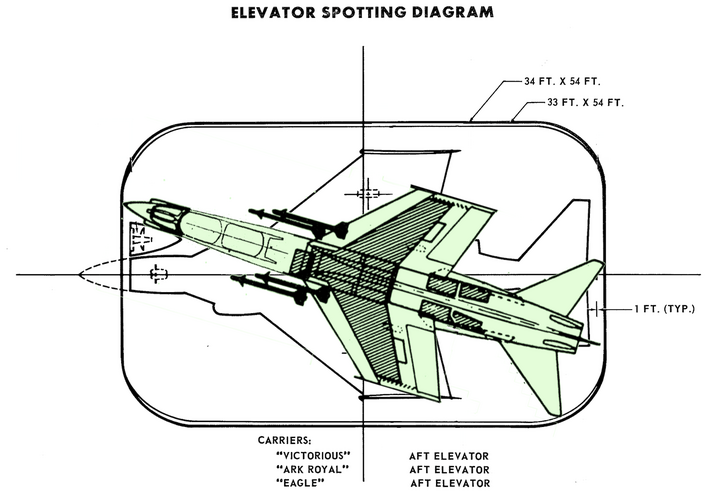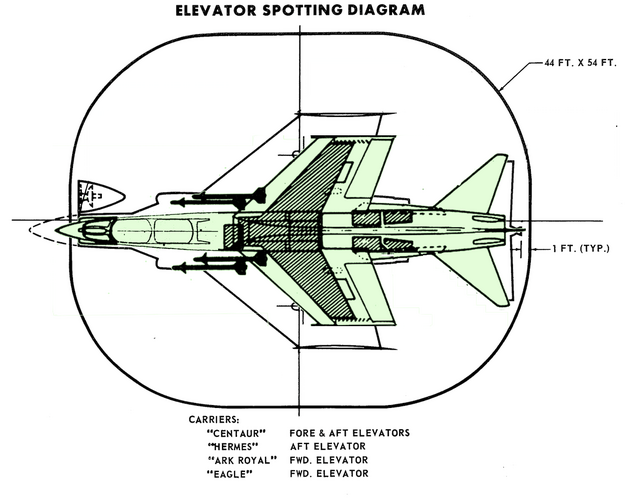You are using an out of date browser. It may not display this or other websites correctly.
You should upgrade or use an alternative browser.
You should upgrade or use an alternative browser.
Royal Navy with F-8 Crusader instead of F-4 Phantom II
Scott Kenny
ACCESS: USAP
- Joined
- 15 May 2023
- Messages
- 11,207
- Reaction score
- 13,573
So any F-8 would have needed a folding nose regardless.Lifts range from 54ft to 58ft.
So the requirement in AW.406 was 52ft folded
orlovsky
I really should change my personal text
- Joined
- 28 May 2016
- Messages
- 268
- Reaction score
- 569
Didn't the French park their F8s on an angle on their lifts?
No need on the deck edge lift; on the forward lift it was a tight fit. Moulin, Clem+Foch, p 98, has a pic with the F-8 non-angled with the remark that 40cm are left.
orlovsky
I really should change my personal text
- Joined
- 28 May 2016
- Messages
- 268
- Reaction score
- 569
- Joined
- 15 July 2007
- Messages
- 4,864
- Reaction score
- 4,501
Check the Take Off distance to 50ft, climb to 40,000ft and acceleration.Now that is odd, as the F-4K was heavier than the B or J version (from 1964) :
View attachment 719858
Spey F4K delivers shorter TO, faster climb and acceleration.
Kiltonge
Greetings Earthling
- Joined
- 24 January 2013
- Messages
- 624
- Reaction score
- 1,156
Now that is odd, as the F-4K was heavier than the B or J version (from 1964) :
True, but that was mitigated with the change to Spey and 40" nose gear.
The USN Phantom could launch and recover on Ark but with strict weight and wind conditions.
Just to compliment this conversation - beautiful profile artwork by MihoshiK
Regards
Pioneer
Sweeeet !
orlovsky
I really should change my personal text
- Joined
- 28 May 2016
- Messages
- 268
- Reaction score
- 569
Check the Take Off distance to 50ft, climb to 40,000ft and acceleration.
Spey F4K delivers shorter TO, faster climb and acceleration.
Sure, but that is from the McAir sales pitch. The F-4K actually got even heavier and the performance advantage of the Speys did not really materialize. Not really clear why; I guess it is down to the massive problems with the reheat development.
From the F-4K manual, @ 50k lbs ISA 137 kts with reheat, 165 kts (!) in mil.
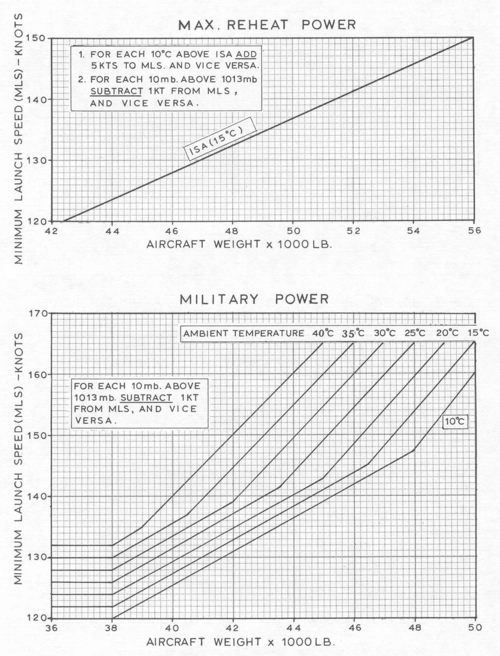
Comparing apples to apples with the F-4B, extended nose gear: ~140 kts in mil (!)
With drooped ailerons and AB probably below 135 kts.
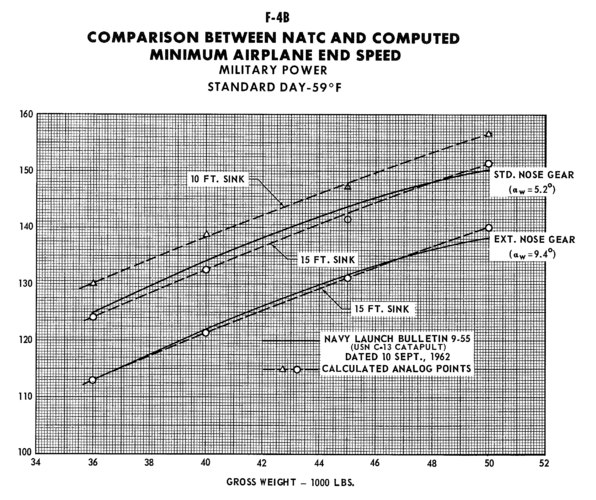
So the extended nose gear did work as expected (and it had been tested before), the Spey was a disappointment. The hoped-for minimum launch speed for the F-4K in AB was around 120 kts (vs 137 from the manual; all @50k lbs).
Scott Kenny
ACCESS: USAP
- Joined
- 15 May 2023
- Messages
- 11,207
- Reaction score
- 13,573
Hmm so Wiki is wrong then. The TF-8A was the same length as a single seater.Wiki.
Bold+italics my emphasis.
Per Vought.org:
"A bold decision was made at the onset of design, that of maintaining the same length as the basic F-8 single place airplane. This required raising the upper profile by 15 inches. Two of the ammunition cans were deleted from the ammunition compartment aft of the cockpit. The weight and balance consideration also dictated that two of the 20-mm cannons be removed from the gun bays...these were the upper guns on each side."
https://www.vought.org/products/html/f8u-1t.html
Per NASA's technical documents, the TF-8A was 53ft / 16.1m long from nose to tail cone, and 54.5ft / 16.6m to the tip of the tail fin. Because of the way it sat (nose up), the actual length overall on deck was 55.5 ft... though like I said perhaps this could be reduced by ~1ft by squaring off the tail fin.
So fitting on a lift would be tight but doable. With a hinged nose cone it would definitely be easier.
- Joined
- 15 July 2007
- Messages
- 4,864
- Reaction score
- 4,501
Blueprints?
 www.the-blueprints.com
www.the-blueprints.com
 www.the-blueprints.com
www.the-blueprints.com
Interesting description and diagram.

 tailhooktopics.blogspot.com
tailhooktopics.blogspot.com
Blueprints > Modern airplanes > Vought > Vought F-8E Crusader
Blueprints > Modern airplanes > Vought > Vought F-8 Crusader
Interesting description and diagram.

Vought F8U-1T Twosader
This is another draft of a subject that I am interested in but for which I lack some facts or confirmation of details. With the acquiesce...
Last edited:
NOMISYRRUC
ACCESS: Top Secret
- Joined
- 28 September 2008
- Messages
- 2,305
- Reaction score
- 3,703
Would an anglicised F-8 be subject to the same delays and cost escalations as the anglicised Phantom? I think it would. E.g. the Spey engine for the Phantom took longer than expected to develop at several times the estimated cost and I expect the Spey for an anglicised Crusader to be subject to the same delays and cost overruns.
Here's the TF-8A on those same elevators. Angling doesn't seem to help enough as the elevators are rounded so the tail stabilizers get in the way. So folding nose cone would be needed.The F-4K folded on the diagrams above of the 54 ft lifts is 51ft 10 in. Do you think you could get the F-8 in angled?
Attachments
NOMISYRRUC
ACCESS: Top Secret
- Joined
- 28 September 2008
- Messages
- 2,305
- Reaction score
- 3,703
What does the RAF do when P.1154 is cancelled if the RN buys Spey-Crusader instead of the Spey-Phantom?
NOMISYRRUC
ACCESS: Top Secret
- Joined
- 28 September 2008
- Messages
- 2,305
- Reaction score
- 3,703
It must have fitted the lifts of the RN's existing aircraft carriers or the RN wouldn't have taken the proposal seriously.Here's the TF-8A on those same elevators. Angling doesn't seem to help enough as the elevators are rounded so the tail stabilizers get in the way. So folding nose cone would be needed.
It did fit… with a folding nose cone.It must have fitted the lifts of the RN's existing aircraft carriers or the RN wouldn't have taken the proposal seriously.
NOMISYRRUC
ACCESS: Top Secret
- Joined
- 28 September 2008
- Messages
- 2,305
- Reaction score
- 3,703
It was less than the folded wingspan of the Phantom and marginally greater than the folded wingspans of the Sea Vixen & P.1154RN.Another more subtle point is that the wingfold needs to move inward or else the folded span eats into available width in the hangers to the point it could cut hangered aircraft by a third.
- 27ft 7in F-4K according to Thetford in British Naval Aircraft since 1912.
- 22ft 6in F-8 according to Jane's All the World's Aircraft 1964-65.
- 22ft 3in Sea Vixen according to Jane's All the World's Aircraft 1964-65.
- 22ft 0in "Big Wing" P.1154RN with Spey engines according to Bill Gunston in Modern Combat Aircraft: 5 Harrier.
Last edited:
- Joined
- 15 July 2007
- Messages
- 4,864
- Reaction score
- 4,501
Not a given as Spey replacing J79 in the F4 introduced a wealth of issues, specifically related to the design being tightly wrapped around said US engines. J79 front face sat neatly on the main wing spar, but Spey was shorter.Would an anglicised F-8 be subject to the same delays and cost escalations as the anglicised Phantom? I think it would. E.g. the Spey engine for the Phantom took longer than expected to develop at several times the estimated cost and I expect the Spey for an anglicised Crusader to be subject to the same delays and cost overruns.
But F8 engine bay is rather different and far less issues are likely to arise. The main potential problem is adjusting the inlet to the higher mass flow, something which also afflicted the F4K.
Which ought to be fairly easy to resolve on the F8.
orlovsky
I really should change my personal text
- Joined
- 28 May 2016
- Messages
- 268
- Reaction score
- 569
Caygill, Phantom from the Cockpit, has a whole chapter on the Spey's teething troubles. A laundry list, mostly performance and reliability, much of it connected to the new afterburner. Also, bleed air reducing performance excessively - and the F-8J and F8E-FN had blc as the F-4.
Another problem was the lack of climb of the F-4K after wave-off or bolter, maybe due to the bleed air problem (or CoG?): "...excessive sink on wave-off, the aircraft taking six seconds to establish a positive rate of climb, and excessive ground roll before reaching rotation speed in the case of a bolter, the F-4K taking about 1,000 ft compared with 300 ft for the F-4J."
And the AB took 3 seconds to ignite, which is probably a bit hairy on launch and may explain the excessive launch speeds for the F-4K in mil power.
All those problem would probably have occurred in the F-8, too.
Another problem was the lack of climb of the F-4K after wave-off or bolter, maybe due to the bleed air problem (or CoG?): "...excessive sink on wave-off, the aircraft taking six seconds to establish a positive rate of climb, and excessive ground roll before reaching rotation speed in the case of a bolter, the F-4K taking about 1,000 ft compared with 300 ft for the F-4J."
And the AB took 3 seconds to ignite, which is probably a bit hairy on launch and may explain the excessive launch speeds for the F-4K in mil power.
All those problem would probably have occurred in the F-8, too.
Rule of cool
ACCESS: Top Secret
- Joined
- 16 January 2024
- Messages
- 1,840
- Reaction score
- 2,473
My issue with the RN going the F8 is that overall it's putting lipstick on a pig. The RN is getting a lower performance aircraft than they can handle on their most capable carriers in order to retain their least capable carriers.
As we've seen elsewhere the British carrier fleet wasn't scrapped for logical, rational reasons but rather political ones which is just as likely to happen if the RN got the F8 as the F4. At best getting the F8 might kick the can down the road a couple of years, but it won't get a powerful RN carrier force into the 80s, only investment in the most capable aircraft and ships will do that.
As we've seen elsewhere the British carrier fleet wasn't scrapped for logical, rational reasons but rather political ones which is just as likely to happen if the RN got the F8 as the F4. At best getting the F8 might kick the can down the road a couple of years, but it won't get a powerful RN carrier force into the 80s, only investment in the most capable aircraft and ships will do that.
Some of the F-4Ks’ problems were common to all BLC installations and were already known. Mainly related to poor approach characteristics: 1) high sink rate if you chop power (as this also reduces blow) and 2) lower acceleration (due to the power diverted to the BLC)… both potentially serious problems on a carrier jet.All those problem would probably have occurred in the F-8, too.
Dassault had trouble with its Avon Etendard IVB prototype because of this - great aircraft on paper for the Colossus class CVLs but the approach characteristics on BLC were nasty. Later the F-8J’s BLC was also heavily criticized by pilots.
Throw in a turbofan like Spey and that adds an extra layer of difficulty due to slower spool-up time. (Again not unique to the F-4K.. was also a problem later for the Jaguar M).
So yes… a Spey Crusader with BLC probably would not have been fun on approach.
My issue with the RN going the F8 is that overall it's putting lipstick on a pig. The RN is getting a lower performance aircraft
What extra performance was needed though? The F-4 had better acceleration in the vertical and a higher top speed, but was never known as a great dogfighter. Also the lack of guns was a problem until more reliable air to air missiles became available in the 80s.
orlovsky
I really should change my personal text
- Joined
- 28 May 2016
- Messages
- 268
- Reaction score
- 569
What extra performance was needed though? The F-4 had better acceleration in the vertical and a higher top speed, but was never known as a great dogfighter. Also the lack of guns was a problem until more reliable air to air missiles became available in the 80s.
The french Crusaders were the only ones to get a basic bvr capability and I don't think you'll get a large radar dish into the F-8 without designing essentially a new aircraft.
orlovsky
I really should change my personal text
- Joined
- 28 May 2016
- Messages
- 268
- Reaction score
- 569
My issue with the RN going the F8 is that overall it's putting lipstick on a pig. The RN is getting a lower performance aircraft than they can handle on their most capable carriers in order to retain their least capable carriers.
As we've seen elsewhere the British carrier fleet wasn't scrapped for logical, rational reasons but rather political ones which is just as likely to happen if the RN got the F8 as the F4. At best getting the F8 might kick the can down the road a couple of years, but it won't get a powerful RN carrier force into the 80s, only investment in the most capable aircraft and ships will do that.
Funny thing with that, even in the F-8J version the Crusader would need 35-40 kts wod on the low pressure, short bs4 or bs5. With the Spey miracle not working, the RN would have got the F-8 not flying from Hermes, maybe Ark Royal only....
- Joined
- 5 May 2007
- Messages
- 1,461
- Reaction score
- 2,797
I'd actually be thinking Olympus for the Crusader. The J57 wasn't a small engine, and a few aircraft planned for the J67 (i.e. a licenced Olympus) wound up with J57s when Wright couldn't make it work.Well yes, though an earlier Avon or dare we say late AS Sapphire Crusader might resolve this....
- Joined
- 15 July 2007
- Messages
- 4,864
- Reaction score
- 4,501
That's more F8U-III territory.....I'd actually be thinking Olympus for the Crusader. The J57 wasn't a small engine, and a few aircraft planned for the J67 (i.e. a licenced Olympus) wound up with J57s when Wright couldn't make it work.
Though that's an interesting AH, if Vought had ventured not just a smaller Crusader design around J65 (Sapphire only ....not quite upto AS's level) but also a scaled up version around Olympus, Conway or Gyron earlier.
Problem is this us all around the 50's nadir of US-UK relations.
- Joined
- 5 May 2007
- Messages
- 1,461
- Reaction score
- 2,797
Not really, there's about as big a difference between a 100-series Olympus and a 200-series Olympus as between a J57 and a J75. Plus, several US types (including the F-102) were designed for the Olympus and wound up with the J57. Going the other way ought not to be too problematic.That's more F8U-III territory.....
Rule of cool
ACCESS: Top Secret
- Joined
- 16 January 2024
- Messages
- 1,840
- Reaction score
- 2,473
What extra performance was needed though? The F-4 had better acceleration in the vertical and a higher top speed, but was never known as a great dogfighter. Also the lack of guns was a problem until more reliable air to air missiles became available in the 80s.
By performance I mean more than top speed. The F4 had greater flight endurance, much greater combat persistence from it's big missile loadout, far greater radar performance with look-down shoot-down capability and a much 'fatter' performance envelope.
All of this adds up to far greater capability than a hotted up 50s transonic gun fighter force could ever provide.
NOMISYRRUC
ACCESS: Top Secret
- Joined
- 28 September 2008
- Messages
- 2,305
- Reaction score
- 3,703
A question to the forum.By performance I mean more than top speed. The F4 had greater flight endurance, much greater combat persistence from it's big missile loadout, far greater radar performance with look-down shoot-down capability and a much 'fatter' performance envelope.
In the last six months I've noticed that the rest of the world (i.e. everyone but me) has been saying "loadout" when they mean load. Why?
It's become as irritating "swap out" when people mean "take out", "swap around", "swap over", "swap", or "change" and the over use of target as a synonym for aim, attack, bomb, concentrate, hit & spend and I think target shouldn't be used as a verb in the first place. It's playing havoc with my inner Ed Reardon.
- Joined
- 15 July 2007
- Messages
- 4,864
- Reaction score
- 4,501
A good point!Not really, there's about as big a difference between a 100-series Olympus and a 200-series Olympus as between a J57 and a J75. Plus, several US types (including the F-102) were designed for the Olympus and wound up with the J57. Going the other way ought not to be too problematic.
Olympus OL.14R was the smaller option on OR.339 proposals.
Something like OL.101 was 40" diameter or so if memory serves and 127" long.
Quite plausible....
Considering J57-P-23 is 39" diameter and 244" long
Last edited:
Scott Kenny
ACCESS: USAP
- Joined
- 15 May 2023
- Messages
- 11,207
- Reaction score
- 13,573
It's a grunt thing, got picked up from ground pounders and then spread around.A question to the forum.
In the last six months I've noticed that the rest of the world (i.e. everyone but me) has been saying "loadout" when they mean load. Why?
"Targeting" is the verb. "Target" is either an object or a noun.It's become as irritating "swap out" when people mean "take out", "swap around", "swap over", "swap", or "change" and the over use of target as a synonym for aim, attack, bomb, concentrate, hit & spend and I think target shouldn't be used as a verb in the first place. It's playing havoc with my inner Ed Reardon.
The key point people are missing is Olympus was too wide for the supersonic fighters for which it was slated. Your fineness ratio wasn't its strength. For large aircraft like the Concorde it was less of an issue. Same issue when Spey was stuffed into Phantoms. The wider engines dramatically increased drag at supersonic speeds.
Kiltonge
Greetings Earthling
- Joined
- 24 January 2013
- Messages
- 624
- Reaction score
- 1,156
Caygill, Phantom from the Cockpit, has a whole chapter on the Spey's teething troubles. A laundry list, mostly performance and reliability, much of it connected to the new afterburner. Also, bleed air reducing performance excessively - and the F-8J and F8E-FN had blc as the F-4.
The UK F-4 BLC is a bad example, it was an awful compromise because of the wing and short deck.
The F-4 wing is low-aspect ratio which means it needs lots of AoA to generate lift, but even with the 40" nose gear it could only get 9 degrees of alpha on the catapult. On the British carriers the Phantom pilot had to crank to 15 degrees of alpha once over the bow, but to get that huge alpha the stalling speed had to be reduced and this was done with leading-edge BLC. LE BLC reduces stall but doesn't increase lift, you have to add alpha for that. This threw away 6,600lb of combined wet thrust with no recovery from the BLC jet-effect you get with flap-blowing.
Even worse, on landing, more BLC had to be added so they further tapped the HP 12th stage for higher-pressure air, which then further reduced thrust in a vicious spiral. Something like 12,000lb of thrust was lost, nearly a third.
The F-8 had trailing-edge BLC, like the Bucc, which with its high-aspect wing directly increases lift as you add BLC pressure without having to increase the AoA.
Last edited:
orlovsky
I really should change my personal text
- Joined
- 28 May 2016
- Messages
- 268
- Reaction score
- 569
The UK F-4 BLC is a bad example, it was an awful compromise because of the wing and short deck.
The F-4 wing is low-aspect ratio which means it needs lots of AoA to generate lift, but even with the 40" nose gear it could only get 9 degrees of alpha on the catapult. On the British carriers the Phantom pilot had to crank to 15 degrees of alpha once over the bow, but to get that huge alpha the stalling speed had to be reduced and this was done with leading-edge BLC. LE BLC reduces stall but doesn't increase lift, you have to add alpha for that. This threw away 6,600lb of combined wet thrust with no recovery from the BLC jet-effect you get with flap-blowing.
Even worse, on landing, more BLC had to be added so they further tapped the HP 12th stage for higher-pressure air, which then further reduced thrust in a vicious spiral. Something like 12,000lb of thrust was lost, nearly a third.
The F-8 had trailing-edge BLC, like the Bucc, which with its high-aspect wing directly increases lift as you add BLC pressure without having to increase the AoA.
AFAIK there was no change in the blc system from the F-4J, where it worked with the J79.
The short deck problem would have been the same for the "F-8K". Although, the 199 ft BS5 and the 211 ft C-11 are essentially the same length.
So does it come down to "On the British carriers the Phantom pilot had to crank to 15 degrees of alpha once over the bow"? Was that different from the launch on a C-11 (eg Coral Sea)? If so, because of the lower end speed?
Rule of cool
ACCESS: Top Secret
- Joined
- 16 January 2024
- Messages
- 1,840
- Reaction score
- 2,473
I've read that the thrust line of the Spey is 2 degrees angled downward from J79 Phantoms, which would help around the carrier.
Also British Phantoms had a much greater requirement to bring back unused ordnance compared to the USN, which would dump unused bombs into the sea. All of these changes were likely most useful as a heavily bombed up and therefore very sluggish Phantom was coming in to land.
Also British Phantoms had a much greater requirement to bring back unused ordnance compared to the USN, which would dump unused bombs into the sea. All of these changes were likely most useful as a heavily bombed up and therefore very sluggish Phantom was coming in to land.
Scott Kenny
ACCESS: USAP
- Joined
- 15 May 2023
- Messages
- 11,207
- Reaction score
- 13,573
Not that tight. Olympus 101 is all of 1" larger in diameter than J57. Olympus 593 is definitely much bigger, 48" diameter versus J75's 43".The key point people are missing is Olympus was too wide for the supersonic fighters for which it was slated. Your fineness ratio wasn't its strength. For large aircraft like the Concorde it was less of an issue. Same issue when Spey was stuffed into Phantoms. The wider engines dramatically increased drag at supersonic speeds.
1" may not sound like much but its a dramatic increase at supersonic speeds.
Some mentioned the Bucc. Can anyone imagine the F-8's tilting/high incidence wing mechanism being added to one? Or how about a frankenplane F-8 incidence wing added to a naval EE Lightning?
Some mentioned the Bucc. Can anyone imagine the F-8's tilting/high incidence wing mechanism being added to one? Or how about a frankenplane F-8 incidence wing added to a naval EE Lightning?
Similar threads
-
Vought Crusader for F-X (1962) instead of Northrop F-5A
- Started by Archibald
- Replies: 18
-
MOTS Phantom for the RN?
- Started by Rule of cool
- Replies: 432
-
Royal Navy 60s Carrier options: I should know the answers to these
- Started by uk 75
- Replies: 8
-
The Fleet Air Arm pivots toward Harriers and Escort cruiser - right from 1962
- Started by Archibald
- Replies: 68
-
CVA-01 - What was the RN carrier plan 1966-1976
- Started by Thorvic
- Replies: 138

